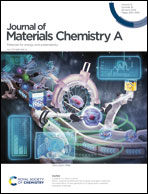Linker engineering in UiO-68-type metal–organic frameworks for the photocatalytic thioamide cyclization†
Abstract
Metal–organic frameworks (MOFs) demonstrate strong potential for application in photocatalysis owing to their tunable compositions and structures. However, systematically controlling the photoelectronic properties of MOFs remains a great challenge. Herein, we show that linker engineering is a powerful strategy for systematically tuning the light absorption and charge-separation behavior of UiO-68 type MOF photocatalysts, using benzothiadiazole-based dicarboxylic acids as linkers. Remarkably, the introduction of different benzothiadiazole units onto the linkers led to distinctly different activities of the resulting MOFs (UiO-68, UiO-68-Bs, UiO-68-Ph, and UiO-68-Py). Among these catalysts, the integration of a fully conjugated benzothiadiazole acceptor and pyrene donor into UiO-68-Py allowed it to serve as a highly efficient and recyclable photocatalyst for thioamide cyclization under mild conditions.



 Please wait while we load your content...
Please wait while we load your content...